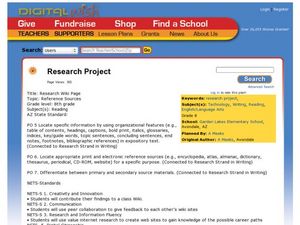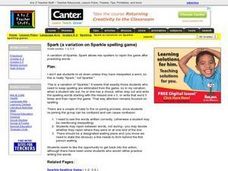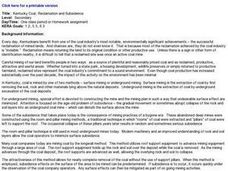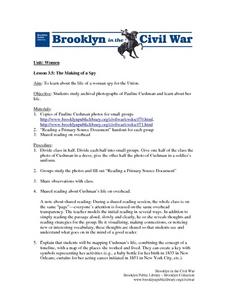Edgemont Elementary School
Scientific Method Unit
Four out of five teenagers experiment with science by accident. This unit teaches the five parts of the scientific method through examples, guided practice, independent practice, and then through a hands-on experiment. Each step is...
EngageNY
Looking More Carefully at Parallel Lines
Can you prove it? Making assumptions in geometry is commonplace. This resource requires mathematicians to prove the parallel line postulate through constructions. Learners construct parallel lines with a 180-degree rotation and then...
National Institute of Open Schooling
Ionic Equilibrium
Scientific studies show the older we get, the more acidic we become. The activity extensively teaches high schoolers about acids and bases. By the end of the 14th installment of 36, they can define and explain three concepts of...
Bowels Physics
Magnetic Fields and Forces
Every knows that opposites attract! Here's a presentation that uses this background knowledge to explain magnetic fields and forces. The resource also explains the shape of magnetic fields and how to determine the direction of forces.
Do2Learn
Classroom Observation Form
Monitor individual students during a classroom observation with a template form. Three pages of fields prompt the observer to note the class member's affect, behavior, peer interactions, and presence of accommodations.
College Board
Choices and Consequences
Paul Fisher, the main character in Tangerine, comes to see that it's the choices in life that lead to the consequences that make all the difference. A unit study of Bloor's young adult novel leads readers down this same path.
University of California
The End of the Cold War (1979-1991)
Scholars use primary and secondary documents, as well as video evidence, to investigate the end of the Cold War. After completing the final installment of an eight-part series, class members better understand the issues surrounding the...
Community High School of Vermont
Habits of the Mind
An informative one-page resource details the 16 Habits of Mind. Habits encourage positive problem-solving, self-awareness, creativity, and dedication—lifelong skills that can be used in both academic and social settings.
Reed Novel Studies
The Lightning Thief: Novel Study
Maybe dark clouds do have a silver lining. Just when Percy from The Lightning Thief thought of his life as doomed, he learned that his father is a Greek god. Scholars work through activities as they read how his life took a drastic turn....
Curated OER
Research Project
Students, with teacher assistance, researching on the Internet and predict whether Puxatawny Phil see his shadow on Groundhog Day.
Curated OER
Invisible Ink
Students wxplore acids and indicators by watching a demostration in which "magic" ink appears. They duplicate the demonstration by writing magic messages using phenolphthalein solution and painting the message with vinegar to show it.
Curated OER
Get to Know: Plants
Students complete a research activity in a schoolyard or park to learn about plants. In this plant lesson plan, students learn the name of the one of more plants. Students describe or draw the plant, pointing our features that...
Curated OER
Spark (A Variation on Sparkle Spelling Game)
Learners participate in a game in which they practice their spelling words, in which each student adds another letter to the word. They are given the chance to rejoin the game if they miss a letter.
Curated OER
Going My Way?
Students, in groups, study how a magnet works and how people use the Earth's magnetic field to orient themselves.
Curated OER
Sharing Under the Sea
Pupils listen to story The Rainbow Fish by Marcus Pfister, discuss why sharing is good, demonstrate understanding of sharing by decorating and sharing cookies, and practice saying "please" and "thank you" as they share icing with other...
Curated OER
Kentucky Coal, Reclamation and Subsidence
Young scholars read and discuss the information that they read on the "Kentucky Coal, Reclamation and Subsidence." They then answer questions in reference to the reading. Some questions that students answer are: What is reclamation?,...
Curated OER
Weapons Of War: The Monitor
Students investigate the building of the first warships of the Civil War. They conduct research using a variety of resources. Students compare and contrast two battleships of the era using a graphic organizer. They also compose a journal...
Curated OER
The Lott House - a History Mystery
Students read a newspaper article about the historic Lott House in Marine
Park, Brooklyn. They study the history of slavery in New York and uncover the secrets of a historic Brooklyn farmhouse that kept slaves and later protected them...
Curated OER
The Sanitary Commission
Students study women's fund raising efforts during the Civil War era.
They participate in a shared reading about the Sanitary Commission and
analyze a political cartoon about women's contributions to the Sanitary Fair.
They write...
Curated OER
Soldier Emily
Students explore the role of women as soldiers during the Civil War period.
They read about a young Brooklyn woman who concealed her identity to
join the army and imagine how her family or fellow soldiers responded. They role play a...
Curated OER
The Making of a Spy
Students study the life of a woman spy for the Union. They study archival photographs of Pauline Cushman and examine her life. They create a key with
symbols representing her activities (e.g., a baby bottle for her birth in 1833 in New...
Curated OER
Box of Mystery
Students are given a box and wrapping paper and are asked to decorate it in a style that is original and creative. The project could be used for content area learning if adapted to include curriculum content. The lesson is designed to be...
Curated OER
Timeline of 9/11
Students explore the series of events that cumulated in the events of September 11, 2001. They understand the importance of the events of September 11, 2001 and the effect on US history. They createa timeline utilizing photos and visual...
Curated OER
Homonyms - Quiz 17
In this online interactive ESL worksheet, students respond to 20 multiple choice questions regarding homonyms. Students check their answers immediately.

























